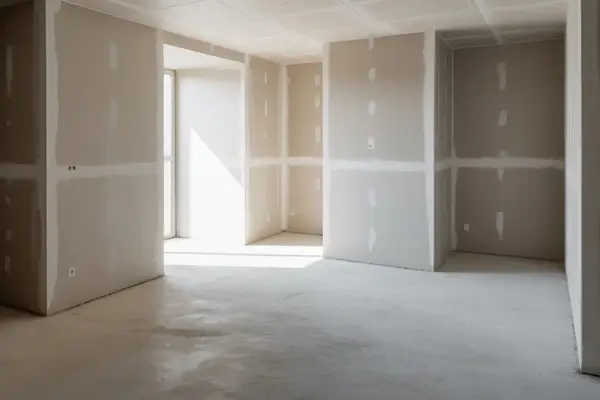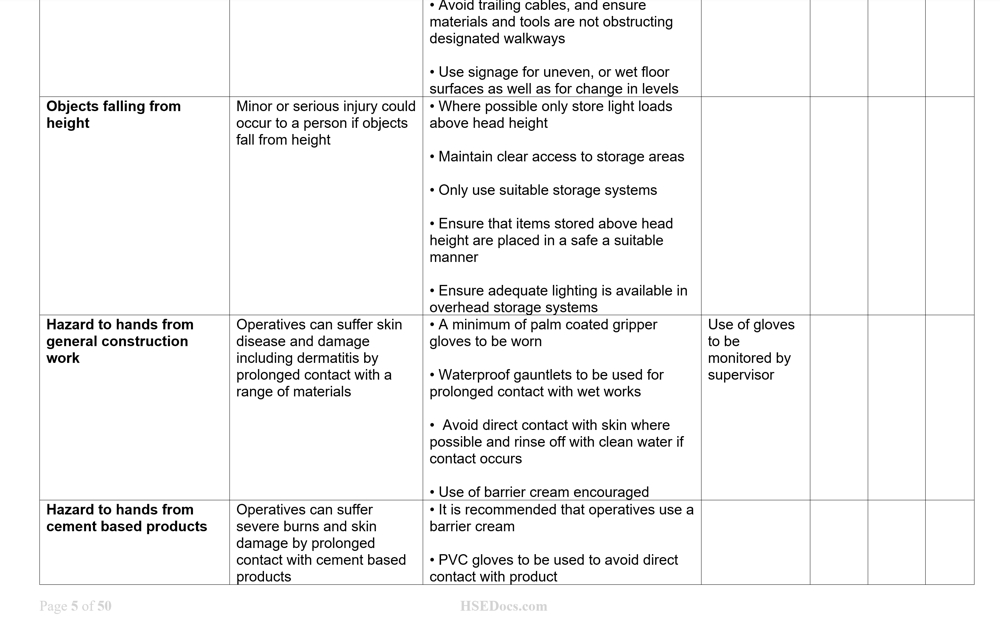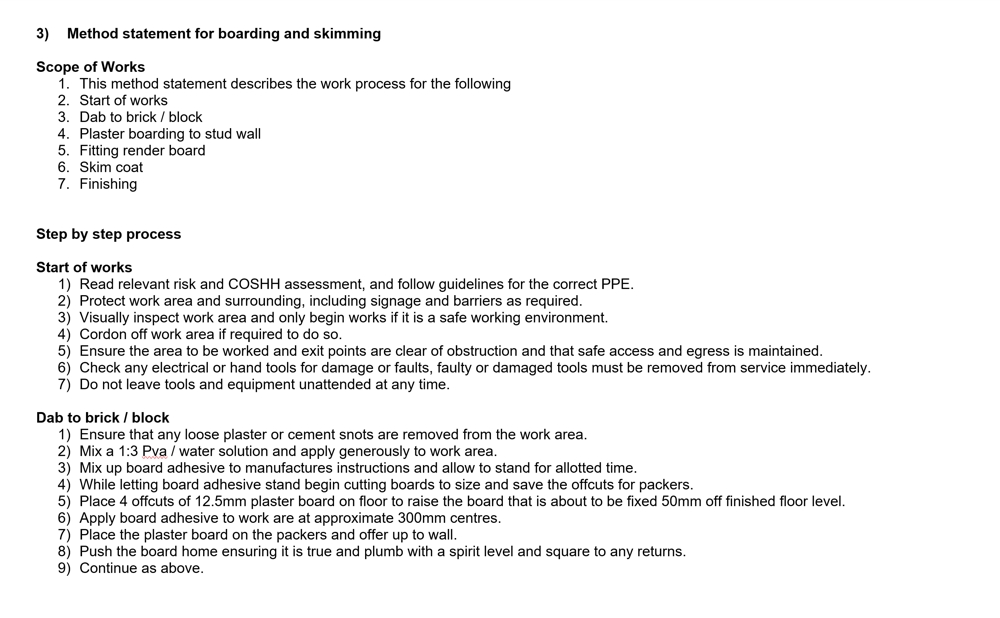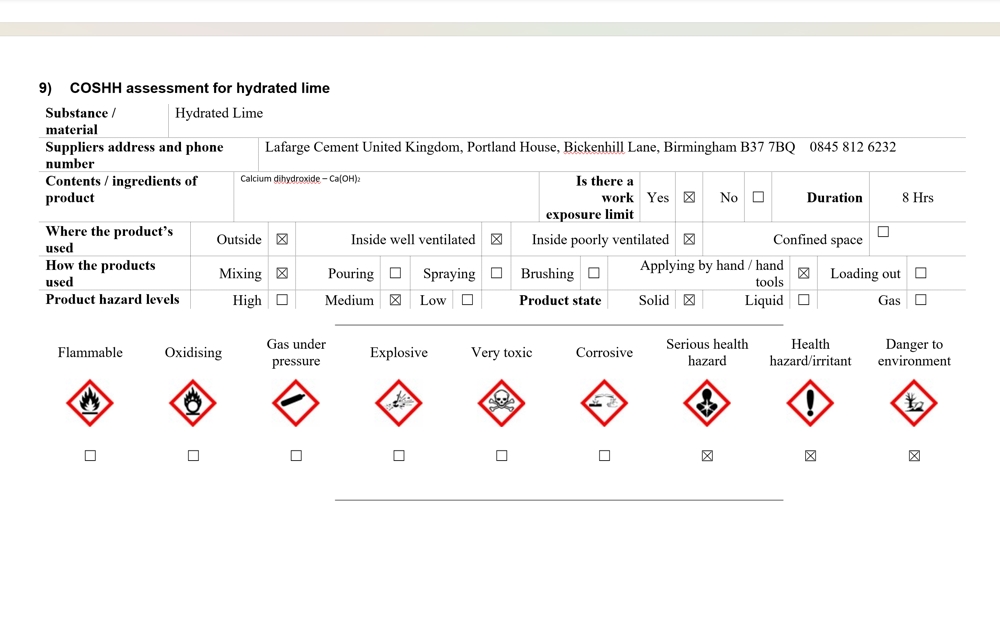Plasterers health and safety RAMs pack. BEST OFFER

Plastering, hacking off, rendering... All the RAMs are in one handy document. A complete H&S package for just £60.00
 |
 |
 |
|
Sample 1 |
Sample 2 |
Sample 3 |
What are RAMS for plasterers?
RAMS, which originally stood for Risk Assessment Method Statement in the realm of health and safety, has expanded in scope to encompass the Control of Substances Hazardous to Health (COSHH) assessments as well. In contemporary practice, many contractors utilize RAMS as a comprehensive Health and Safety package supplied by subcontractors, ensuring a robust approach to workplace safety.
As a fundamental document, RAMS delineates the essential steps required to execute a specific task or activity safely. Its primary aim is to identify potential hazards and outline the control measures necessary to mitigate them, effectively serving as a strategic roadmap that guides workers in maintaining a safe and compliant working environment.
Within the framework of RAMS, Risk Assessments assume a pivotal role. They systematically identify potential hazards inherent in the workplace, evaluate the probability and severity of associated risks, and determine which hazards necessitate further control measures. This risk analysis forms the bedrock of effective safety management, as it helps prioritise actions based on the level of risk.
Method Statements complement these Risk Assessments by providing detailed safe working procedures necessary for executing a task. These statements include comprehensive, step-by-step instructions designed to minimize the identified risks, ensuring that all team members are equipped with the knowledge required to perform their duties safely and efficiently.
Furthermore, plasterers' COSHH Assessments specifically concentrate on analysing the potential dangers posed by hazardous substances commonly encountered in the workplace. These assessments outline appropriate handling procedures, personal protective equipment (PPE) requirements, and emergency measures should exposure occur. Together, these components of RAMS create an integrated safety framework that prioritises risk management and promotes a culture of safety in all work activities.
Table of contents for plasterers package:
Risk assessments for:
- 01) Plastering and rendering
- 02) Risk awareness for areas where asbestos could potentially be discovered
Method statements for:
- 03) Boarding and skimming
- 04) Bonding and skimming
- 05) Hacking off to walls and ceilings
- 06) Rendering
COSHH assessments for:
- 07) Cement
- 08) Drywall adhesive
- 09) Hydrated lime
- 10) Hydraulic lime
- 11) MultiFinish
- 12) PVA
- 13) Tanking Slurry
- 14) Bonding coat
We have compiled a comprehensive document containing all the necessary Risk Assessment and Method Statement (RAMS) requirements, curated based on our vast professional experience and considering our customers' download trends. You can easily access the full table of contents by scrolling down. By purchasing this package, you will have at your disposal the latest Health & Safety (H&S) measures and trends, and you will also be able to showcase your commitment to H&S by displaying the "Health & Safety Gold Standard Award" on your website. This will let your clients, customers, and contractors know that your H&S standards are up-to-date and you take your responsibilities seriously. We continuously strive to update our plastering package with the latest H&S laws and trends, ensuring it remains current and relevant.
The document covers boarding bonding, skimming, hacking off and rendering. It’s professionally written and will increase your chance of winning tenders.
At the heart of our business is a commitment to providing value for money. This means that we believe in offering quality products at affordable prices. Our documents are written by health and safety professionals, ensuring they are accurate and informative.
One of our most popular products is the plastering pack. It is not only great value for money but also very easy to use. The pack comes in docx format, meaning you can edit it in Word™ or any other word processor you prefer. All you need to do is add your company details to the first page, and you're good to go.
Furthermore, you can upload your company logo or customise the document's style to match your brand. This ensures the plastering pack looks professional and consistent with your company's image. This document is:
- Recognised by local authorities.
- Recognised by principal contractors.
- Suitable for CDM sites.
- Approved by H&S managers.
Customer feedback is a testimony to the value and quality we offer.
Risks plasterers can be exposed to:
Falls from height are a particular risk to plasterers, especially if purpose-built access equipment isn’t being used. On smaller sites, scaffold boards spanning milk crates or similar to create raised walkways are still a frequent sight.
The same applies to stairwells, where scaffold boards are often fed through ladder rungs for access.
Slips, trips, and falls are other common incidents, compounded by the size of the area a plasterer can work on and the fact that it’s a wet trade.
Eye injuries from plaster, dust and lime-based render are a common risk, as are manual handling injuries.
Additionally, there are occupational diseases due to asbestos disturbance, hearing loss and white finger from power tool use.
Plaster dust, other airborne dust and silica also contribute to lung-related occupational diseases.
It is important to have knowledge of the various documents needed for risk assessment and management in any project to ensure safety and compliance. Most contracts require certain documents, including risk assessments, method statements, and COSHH assessments, to ensure compliance with safety regulations.
It is important to note that if your company has five or more employees, providing a health and safety policy is mandatory. This document outlines the company's approach to managing health and safety and identifies who is responsible for what.
A risk assessment document is a crucial element that identifies the potential risks associated with a task and the control measures to eliminate or reduce the risks to an acceptable level. This document lists the tasks assessed for risks, possible hazards, and the necessary precautionary measures to be taken.
On the other hand, a method statement describes how a task is to be carried out. However, it is unnecessary to list every step because manufacturers often provide method statements with their products. For example, when mixing drywall adhesive, you write, "Mix adhesive according to the manufacturer's instructions."
COSHH assessments, or Control of Substances Hazardous to Health assessments, are crucial documents that should not be ignored. Your legal responsibility is to provide and list hazardous substances and their potential health and environmental risks. Additionally, they provide information on the necessary first aid and firefighting measures to be taken, ensuring the safety of everyone involved.
Plasterers are highly skilled and trained professionals, and many have been doing their job for years. However, the plastering industry still suffers from frequent fatalities, injuries, and occupational diseases. To address these issues, we recommend providing plasterers with a minimum of three areas of training: asbestos awareness, working at height, and manual handling. This training will equip tradespeople with the necessary knowledge and skills to perform their job and avoid accidents safely. Ultimately, this will benefit everyone involved in the plastering industry.
GET THIS DOCUMENT
£60.00+VAT
- Available in Word™
- Fully customisable
- Add your Company Logo
- UK & EU Compliant

 CART
CART 